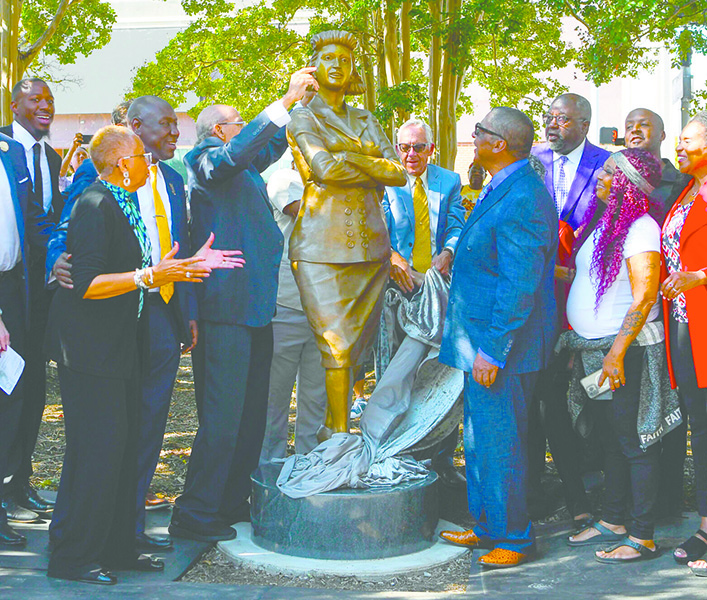Black History
City of Roanoke and Virginia Tech Unveil Statues of Henrietta Lacks
“Honoring Henrietta Lacks’ contributions to medicine.”
#HenriettaLacks #StatueUnveiling #MedicalLegacy #HeLaCells #HealthcareEthics #MedicalAdvancements

By Rosaland Tyler
Associate Editor
New Journal and Guide
A bronze miniature statue of Henrietta Lacks was unveiled on the campus of Virginia Tech on Oct. 4, the same day that the City of Roanoke unveiled Lack’s bronze full-sized statue in a morning ceremony at Henrietta Lacks Plaza in downtown Roanoke on Henrietta Lacks Day in Virginia.
According to news reports, about 100 people stood downtown cheering at the unveiling event that was held in the morning, on Oct. 4, a few days after Lacks would have celebrated her 103rd birthday on Oct. 1. Lacks died of cervical cancer in Baltimore on Oct. 4, 1951.
On the surface, it seems as if the downtown unveiling ceremony dates back to 2021, when Roanoke City Council voted to remove the statue of Confederate General Robert E. Lee from ‘Lee Plaza’ and replace it with Lack’s statue, which was funded with private donations totaling nearly $184,000.
But the ceremonies that were held downtown and on the campus of Virginia Tech actually date back to the time that Lacks moved from Virginia to Baltimore around 1941, received a cervical cancer diagnosis at Johns Hopkins Hospital around 1951, and died the same year. Her cervical cancer cells launched the HeLa cell line, which contributed to major scientific advances.
“She literally changed the world, and it is somewhat biblical when you think about it,” said Attorney Ben Crump, the lawyer for the Lacks family, speaking at the downtown unveiling ceremony.
“She is the history lesson for all medical institutions, research centers, physicians, and scientists,” said Crump.
Lacks’ statue depicts her standing with arms folded in a blazer, long skirt, and heels. The bronze monument located downtown weighs about 400 pounds, stands six feet high and is six inches taller than Lacks actual height.
Roanoke artist Bryce Cobbs created the drawing that Blacksburg sculptor Larry Bechtel used to build the statue. Cobbs said he wanted to portray Lacks as a powerful and dignified figure.
Her well-known HeLa cells paved the way for advancements in HIV, Polio, in-vitro fertilization, gene mapping, and cancer treatments. Those same cells are still being used today.
When Lacks received a cancer diagnosis in 1951, federal laws did not regulate or restrict the use of patients’ cells in research.
“We understand Henrietta Lacks’ place in Roanoke’s complicated history that regrettably included a time of segregated health care,” Nancy Howell Agee, the Chief Executive Officer of the Carilion Clinic, said at the unveiling ceremony on Virginia Tech’s campus.
“Today, we affirm our determined commitment to identify and close gaps in health inequities. We’re humbled standing beside Mrs. Lacks’ likeness. We honor her for her cells’ role in medicine that has saved lives time and time again. And we celebrate her because her story has helped the health care community change the ethics guiding how we care for our patients,” she said.
“The life of Roanoke’s Henrietta Lacks has left an enduring legacy on medical advancements, health care ethics, and patients’ rights,” Lee Learman, the dean of the Virginia Tech School of Medicine, said at the statue unveiling ceremony held on Oct. 4 at The Fralin Biomedical Research Institute at Virginia Tech.
According to news reports, the Fralin Biomedical Research Institute, the Virginia Tech Carilion School of Medicine, and the Carilion Clinic each unveiled statues of Henrietta Lacks in their facilities.
“Our students will look upon her statue each day as a reminder of the trust patients invest in their physicians and the origins of distrust felt by members of historically underserved communities,” Learman said. “With this recognition, our hope is for future generations of physicians to continue shaping more inclusive and caring health care institutions for everyone.”
Lacks, the married mother of five, grew up on a tobacco farm in Clover, a part of Halifax County. She is honored with signs, markers, statues and exhibits in various places of the United States and world.